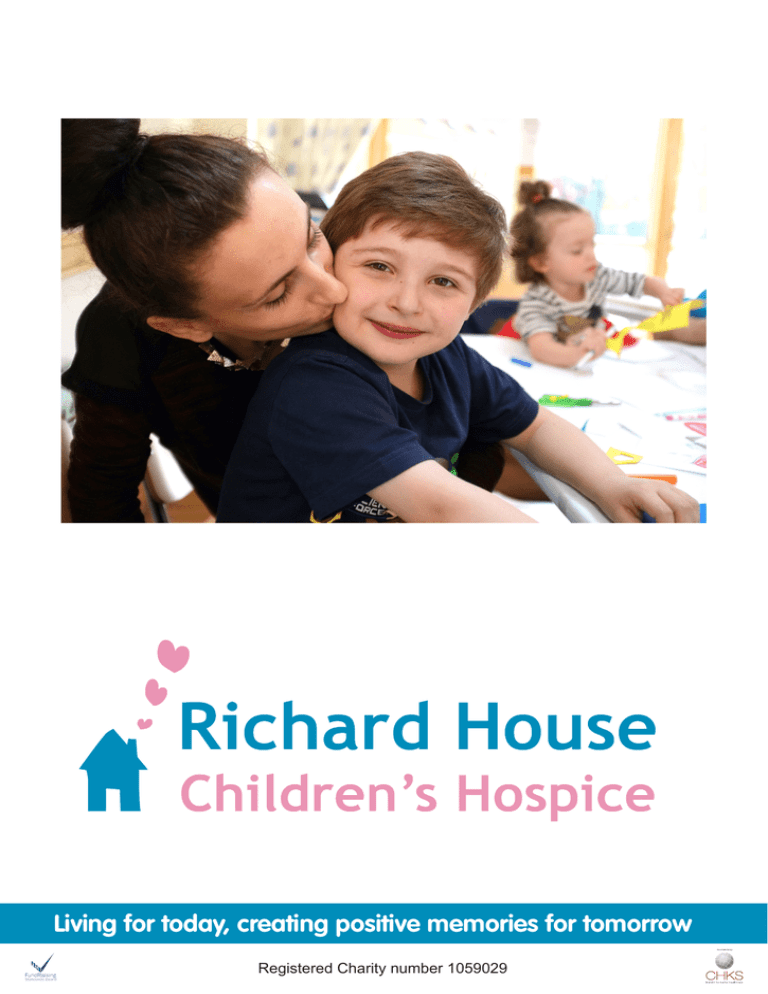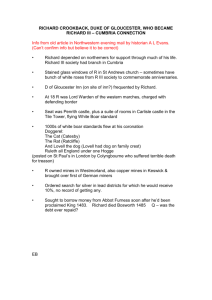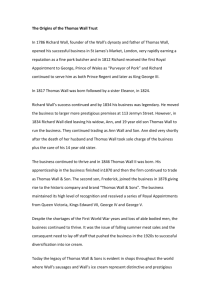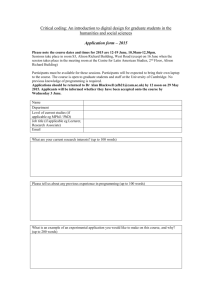Living for today, creating positive memories for tomorrow
advertisement

Living for today, creating positive memories for tomorrow Registered Charity number 1059029 ‘What makes Richard House really special is it moves along with you, it helps you and it doesn’t abandon you. If I could sum it up in one word it would be freedom. You don’t feel shackled down by your impairments or the things that you have to deal with. You’re just happy’ (Young adult) ‘Before, I never knew what a hospice looked like. I imagined rooms full of people dying but it was completely different. It was really welcoming place to be and it didn’t feel gloomy or scary’ (Family member) 2 Page 4 Title Chief Executive statement 5 Review of services 6 Improvement 1 Measuring impact and outcomes for children and their families 8 Improvement 2 Model of Care 10 Improvement 3 Building Project 11 Audit Statement 11 National Audits 12 Local Audits 12 Clinical Audits 12 Clinical research 13 Care Quality Commission registration status 14 What the Care Quality Commission says about us 15 What our partners say about us • Clinical Commissioning Groups (CCGs) •HealthWatch • Health & Wellbeing Board 16 Data handling 23 Progress against previous improvement priorities 3 Chief Executive’s Statement - Peter Ellis Within this inaugural Quality Account, together with our Board of Trustees I wish to acknowledge the work of our dedicated staff and volunteers, without whom we could not deliver the high standard of care and support that we offer to children, young people and their families. This is achieved in partnership with our community and statutory bodies who provide us with the necessary financial resources to deliver care to children, young people and families. Our financial targets, although stringent, are met with these efforts and appreciated. The rising demand for palliative care resulting from more children and young people living with life limiting/life threatening conditions coupled with the continuing uncertain economic environment and the inevitable constraints on funding and provision of care mean that children’s hospices need to think of new, creative and innovative ways in which care and support is offered. We have therefore reviewed our model of care, with the impetus from building improvements to take place in 2014 providing us with an opportunity to broadly look at the design of our service and consider how we deliver holistic, specialist palliative care. Both staff and partners recognise the need to measure the impact our service has on our families, beyond the numbers, and we are ensuring that outcomes from the work of Richard House are better measured and used to facilitate constant evaluation. We aim to make or services responsive and flexible in response to the needs and preferences of children, young people and their families who use our care and support. As with many in the children’s hospice sector, Richard House has undergone significant change and adaptation in recent years to ensure its services are able to maintain and improve the support that has come to be expected of us by those we serve in north east and north central London. Whilst we seek to remain resilient within the ever challenging charity environment, we adhere to our core values and competencies, putting young people, children and families first in everything we do, whilst maintaining professionalism and integrity in the face of death, dying and adversity. We achieve this through working closely with our partners, creating a positive environment and providing a responsive service, nurturing respect and trust. Richard House constantly strives to deepen its relationship with the communities it serves, developing the service in line with identified need through engagement and aiming to reach out to as many families as need us. We continue to pursue excellence in the delivery of our care and innovation in the design of our service and are sure that in playing our role in a wider network of organisations and individuals building compassionate communities we will eventually reach and support those children who need our help. Our efforts to identify outcomes and impact on our families will inform this process to ensure we offer a robust and relevant service. We constantly seek to incorporate best practice and lead in sharing our knowledge across our networks. I am pleased to note that at our last CQC inspection in February 2013, we passed well and received some very positive feedback from inspectors. More on this follows below. This report is an accurate and honest appraisal of our services as delivered in 2013/14. 4 Review of services Richard House Children’s Hospice provides a range of services to support children, their families and carers holistically and enable them to participate in activities which allow for supported family time. The family support service complements the clinical service we provide within the hospice building, offering; • • • • • • • • • • • • • Respite (short breaks) Symptom control Step down from hospital (often before measures are in place in the home) Day care End of life care Play specialist Music therapy Art therapy Mum’s group Dad’s group Siblings group Bereavement support Family trips and activities 5 Improvement Priorities Improvement 1 Assessing Impact and Outcomes for Children, Young People and Families Richard House, both through service user feedback and with the input of the Charities and Evaluation Service (CES), identified that there was greater depth of knowledge to be gained regarding the service, which in turn could lead to better evaluation and enhanced outcomes. It has long been recognised by the charitable sector, that impact and outcomes for families go further than the number of nights respite available or a quantitative measurement. The long term outcome for Richard House is bold and revolves around the lives of children and young people with life limiting, or life threatening conditions, and those of their families, being enhanced. Underlying challenges for families include a social isolation from their own community, friends and wider family and a significant strain on the nuclear family, with a threat to family breakdown. Through working with Caspe Healthcare Knowledge Systems (CHKS) and entering into the third accreditation cycle in 2014, areas for strengthening, improvement and change have also been identified. The accreditation programmes developed by CHKS relate to the organisational and clinical management systems of healthcare organisations. They do not cover specific clinical or individual professional practice. A new post was created in May 2014 of Quality and Information Manager to look deeper into the measurements Richard House use to measure quality and embed service user feedback into processes. We are committed to providing a quality experience for all stakeholders by: • • • • • 6 Making our values and culture explicit and fit for purpose; identifying key processes and systems; developing effective organisational arrangements; focusing on internal processes which are bound up with aims and objectives; fostering ownership and commitment among staff. The development and implementation of a bespoke quality management system, using existing frameworks and methodologies from a range of clinical, change and knowledge management approaches for Richard House will provide a pan organisational framework of governance. This is turn will promote the ethos and practices of accountability and continuous improvement. The role will embed the value and consistent use of management information and tools into the organisation, providing reassurance from a quality and performance perspective that the actions the organisation is taking are having a positive bearing on children, young people and families. Where it is identified that this is not the case and Richard House could be better supporting service users, it will support evidenced based practice and demonstrate change. By asking children, young people, their families and carers their views and opinions (through narrative and questionnaires) we aspire to confirm that Richard House is responsive to, and based upon, the assessed needs of our communities. The Quality Improvement Strategy that has been developed is ambitious, but will provide not only greater evidence that we adhere to statutory regulations, but that we are enhancing as many lives as possible. 7 Improvement 2 Revising the model of care Achieving optimisation of the use of services delivered by Richard House is key to enhancing the lives of children, young people with life limiting conditions and their families in their journey through life death and beyond. Richard House will review the model of care delivery to ensure that we serve three specific aims in the support of children young people and their families: to enable communities to be more involved to increase the ability of other services to better meet their needs and preferences,, increase their ability to lead the life they choose. Our current model of care recognises that any child or young person is a member of a family (with parents/carers, siblings and the wider family) and that they live within their community. In offering support to a child or young person with a life limiting condition, partnership with the family, friends and the wider community is essential if a child or young person is going to receive regular and sustainable care and support, whilst also harnessing the professional range of services as required. However, there is a need to consider a revised model due to increasing influences (some financial), expertise, feedback and ideas from a variety of sources to improve on what we can achieve. Diagram (1) highlights the multifaceted dimensions to consider ensuring Richard House is in a position to be a leading provider for children’s palliative care Diagram (1): Demonstrating some of the relationships and partnerships to consider in order to effectively support a child or young person with a life limiting condition referred to Richard House 8 Revising our model of nursing care clearly defines the potential for care activities across Richard House and helps future-proof services. The revised model serves as a preliminary step, progressing over future years with ambition, to achieving a range of functional, efficient palliative care services from Richard House. These services should be sustainable for families, and communities, whose children have a life threatening or life limiting condition needing professional support across key areas, optimising the uptake of services we provide: • Family Support Services including recreational activities to introduce and familiarise families (and siblings) into a palliative care setting with additional therapeutic activities such as specialist play, art and music therapy and pre and post bereavement support • Short breaks providing specialist respite care • Symptom management • A robust Family Information Service signposting towards local providers and stakeholders • End of life care The framework for improvement relates to delivering direct care or supporting other care givers delivering care in a range of settings: the Richard House building; an outreach setting such as the family home; a school or residential setting. It will be important to determine what the unique role of Richard House care services can be within the local community so further development will involve consultation with a range of service user groups, key stakeholders groups of those already providing community care. Our residential facility is changing from 8 beds to 4 beds as we develop the range of services needed to achieve the specific aims identified earlier. The impact of this decision for families will be monitored as part of a wider consultation not only to find out how reduced capacity may affect them, but to how many families actually need the residential service at all. We need to determine what is needed from us and from whom, how we can be more flexible as families experience increased resilience because of successful strategies in therapeutic activities and, how to become important to families needing transition services as life expectancies increase. Staff will remain suitably informed, trained and competent to deliver palliative care from all who seek it. It is vital for sustainability in the changing environment of competitive healthcare providers that Richard House employ and retain the right staff, they are given the right skills, and are deployed in the right place. No one individual in the service will be perfect but the team can come close. Therefore, there are three main aspects to consider in establishing a refined model of care as per the work undertaken with the Charities Evaluation Services over last year: ensuring the delivering of quality and evidence based practice, making the best use of resources and the continuation of strategies to support families to cope and strengthen their resilience. 9 Improvement 3 Building Work To be truly holistic in our care service, we recognised the considerable benefit that a building redesign would have for children, young people and their families. This followed a review of the layout in consultation with our stakeholders. We not only looked at the physical impact, including room sizes and the need for more community space, but also at the psychological impact. As the children’s hospice concept evolves, we believe our new layout design is dynamic, links the haven of our award winning gardens into the fabric of the building and provides the foundation to achieve our strategy. Richard House was built over twelve years ago as London’s first children’s hospice and was based on a very specific needs assessment. These needs have since changed. Richard House’s community has become more diverse, continues to be one of relative poverty and represents a more transient population with different needs. Over time more children, young people and their families have spoken out about obstacles in the current design of our building around issues to do with access, light, room sizes and communal space: obscure access makes visitors uncertain; limited natural light raises anxiety levels; small rooms prevent flexibility; and lack of communal space promote feelings of isolation. In 2010 stakeholders began considering what changes could address these issues and we employed architects to draft a building proposal. The arrival of the Department of Health (now NHS England) Capital Grant Programme in 2012 allows us the possibility to complete this work. Most of the children that use our service are referred to us from our twelve surrounding boroughs in North East and North Central London, as their local hospice or hospice of choice. Referrals are made by one of a number of professionals, or families can self refer. Richard House employs a Statutory Partnerships Manager who works with health and social care commissioners to ensure that children, young people and families can select Richard House as their specialist care provider of choice; our Clinical Services Managers ensure families are given fair opportunity to access our service by assessing all families on an individual needs basis which incorporates critical factors such as their cultural needs, family setting, geographical location and financial needs. In keeping with Richard House’s vision: “for communities to have space where they can journey together to create memories of living and dying”, this project aims to redesign aspects of the hospice so that it is more attuned to the medical, physical, psychological and social needs of children, young people and their families. 10 Audits Statement 1. The reports of no national clinical audits were reviewed by the provider in 2013/14. 2. The reports of 17 local clinical audits were reviewed by the provider in 2013/14 and Richard House intends to take the following actions to improve the quality of healthcare provided; • Medication management audit, in collaboration with the pharmacist from St Joseph’s Hospice, Hackney. Additionally, Richard House Children’s Hospice underwent a Caspe Healthcare Knowledge Systems (CHKS) audit on 13th March. This looks at all aspects of the documentation and recording of care within the hospice. National Audits Richard House take part in national audits as part of the national, umbrella children’s hospice and palliative care charity, Together for Short Lives. Completing in March 2014, Richard House participated in information gathering for the Palliative Care Funding Review (PCFR). The pilot site was established to collect data as part of a DH (later NHS England) project to develop a per-patient palliative care tariff as laid out in the 2011 Palliative Care Funding Review (PCFR). The aims of the data collection were: • • to provide evidence of the sort of palliative care provision being provided; to test the cost classification system put forward by the PCFR team. The Director of Family and Care Service is a member of the Healthcare Quality and Improvement Partnership (HQIP) National Clinical Audit Forum The Director of Family and Care Services receives minutes from the NHS National Advisory Group on Clinical Audit and Enquiries (NAGCAE) Richard House is not directly involved in National Clinical Audit and Patient Outcomes Programmes (NCAPOP) but at times may be asked to contribute on relevant programmes such as Clinical Outcome Review Programmes including the Maternal, Newborn and infant Programme and very likely the pending larger Child Health Programme in 2015. 11 Local Audits Clinical Governance The Clinical Governance Committee advise and discuss recommendations. They are comprised of; • Dr Finella Craig – Consultant - Great Ormond Street Hospital (GOSH) • Katrina McNamara – Together for Short Lives • Two members of the Senior Management Team, including the Director of Family and Care Services • Three Trustees • Consultant Pharmacist joining Summer 2014 Clinical Audits Areas that may be considered and which are regularly audited are; • Medication management •Accidents • Infection control such as hand washing and equipment • A comprehensive clinical record audit on a monthly cycle which includes: referral details, end of life care plan, observation and consultation reports made by all health professionals and arrangements for continuing care. New elements to be audited will be a more robust core care pathway including preferred place of death. • Controlled Drug Audit – This is undertaken by the Director of Family and Care Services on a quarterly basis using the Help the Hospices template and will now be undertaken by our pharmacist. • The Director of Family and Care Services attend the Controlled Drugs Local Intelligence Network [LIN] Clinical research Richard House Children’s Hospice has a policy that we do not undertake research at this time. This policy is reviewed regularly, mindful that we may need to take up a research role as we continue to consider the impact of our work. 12 Care Quality Commission Registration status Richard House Children’s Hospice are regulated by, and registered with, the CQC in the following way; Registered Provider - Registered Manager - Peter Ellis, Chief Executive, Richard House Trust Jon Wheater Overview of the service Richard House provides care and support for children and young people with life-limiting / life threatening and complex healthcare conditions, and their families, in North East and North Central London. The services include specialist nursing and medical care, short breaks and respite care, end of life care, and family support before or after death. Type of service - Regulated activities - Hospice services Diagnostic and screening procedures Treatment of disease, disorder or injury 13 What the Care Quality Commission says about us Health service watchdog the Care Quality Commission (CQC), made an unannounced visit on 27 February 2013 to Richard House Children’s Hospice. In particular they looked at the personal care or treatment records of people who use Richard House and observed how people were being cared for and talked with carers, family members and staff. They assessed Richard House on a number of criteria, all of which were met, for its care of infants, children and young adults with life-limiting, life-threatening conditions and support to their families. People interviewed during the inspection told the CQC that “the hospice provided a lifeline”. Staff at the hospice were commended to the CQC with one parent telling the watchdog, ‘The staff are never phased by my son’s condition’. The CQC commented on the “consistent one-to-one nurse to patient allocation” as well as the play and care support workers who provide additional services. The inspectors also noted that volunteers provided a range of services within the hospice, which were ‘positively evaluated by patients and their families and staff’. Children who used the service told the CQC that they liked the fact they could personalise their rooms, that their hobbies were known and accommodated and said they particularly liked participating in arts and crafts sessions and parties at the hospice. The CQC praised Richard House for the way in which its staff kept up to date with, and applied new innovations in practice as well as the way the hospice worked collaboratively with a number of external agencies and professional networks. 14 Richard House was assessed on, and met all the requirements on, five standards: The full CQC report can be viewed here - www.cqc.org.uk/location/1-112020930/inspectionsummary What our partners say about us HealthWatch Charlotte Ladyman, Manager of Newham HealthWatch said the following, ‘It seems Richard House accommodates a breadth of [children] from a range of backgrounds in Newham and their varying cultural palliative needs’. Clinical Commissioning Groups (CCGs) Unfortunately, although the Quality Account was received by our CCG partners, they have not provided a response. Health & Wellbeing Board Unfortunately, although the Quality Account was received by Newham Health and Wellbeing Board, they have not provided a response. 15 Data management and handling Number of patient records Richard House hold detailed information on service users, be they children, young adults, their families or carers. Richard House handles a great deal of very sensitive and high confidential personal information on a daily basis. Richard House believes that all people regardless of their age have rights to confidentiality. The information is often family specific and may include personal health details or other personal details. The confidentiality of this information must be respected and maintained at all times. Everyone therefore is required to act in such a manner as to uphold the principle of confidentiality. The following is strictly adhered to; • • • • The Common Law Duty of Confidentiality; This means that information given in confidence must not be disclosed without a person’s consent unless there is a valid justifiable reason such as a requirement of a statute of law or it is judged that there is an overriding public interest to do so. The Data Protection Act (1998); This is covered by the policy on Data Protection The Caldicott Report; report undertaken by the Caldicott Commission which made a number of recommendations on the use and disclosure of patient identifiable information. The Caldicott guardian is the Director of Family and Care Services. Professional Codes of Practice; All health professionals must adhere to their professional codes of practice which include significant sections on patient confidentiality. We maintain hard copy and database information for the children using our service. All children have a Care Record, which is held securely in filing cabinets, in a locked office, with access granted to relevant staff. 16 Quality of systems and data collection The Care database and records hold NHS numbers for all of the children and young people using the service. This system is accessed by a limited number of people, whose roles determine that it is essential. Other staff requiring data (e.g. number of respite nights used) will request this information from the Quality and Information Manager. Throughout the period 2013/14 the number of children, young people and their families supported were; Who Richard House supported Who Richard House supported Total number of families supported in 2013/14 Children Bereaved families Siblings Bereaved siblings Number 328 240 125 399 121 Richard House had 59 new referrals at the beginning of the 2013/14 period; 17 Referrals were received from a range of sources; Details are held on the ages and sex of children and young adults using the service; 18 Information on diagnostic categories is maintained to assist the service in providing the correct level of support to those children and young adults requiring specialist palliative care; 19 Deaths are recorded to ensure that end of life preferences are met; Place of death Home Hospital Other hospice Richard House Children’s Hospice 20 Number of Deaths 2 14 2 2 Ethnicity is recorded to ensure that barriers to using the service are reduced; Ethnic Origin Number of Children Accepted Any other ethnic group Asian or Asian British - Any other Asian or Asian British Bangladeshi Asian or Asian British Chinese Asian or Asian British - Indian Asian or Asian British - Not Stated Asian or Asian British Pakistani Black or Black British - African Black or Black British Caribbean Black or Black British - Not Stated Black or Black British - Other Black Mixed - Any other Mixed - White and Asian Mixed - White and Black African Mixed - White and Black Caribbean White - any other White - British White - English White - Gypsy or Irish Traveller White - Irish 1 Number of Children Supported 4 1 5 46 3 1 14 9 2 30 8 3 34 17 1 1 6 1 1 1 5 2 3 1 2 2 1 2 16 36 7 1 2 1 21 Errors and coding Richard House use the ACT categories to aid in the referrals process. Data is not regularly collected or collated on ICD10 codes. There have been no recorded errors in this period. The number of children who fall within each ACT category are; ACT category None set 1 2 3 4 22 Number of children in category using RHCH service 4 21 18 60 137 Progress against previous improvement priorities These cannot be reported on as the 2013/14 is the first Quality Account Richard House has produced. 23







